4.6.5. PARKING DESIGN AND LOCATION.
A. Location and Use of Parking Facilities.
1. Generally.
a. Required parking spaces shall be located on the same lot with the principal building or the primary use unless otherwise permitted in Subsection 1.b below.
b. The Planning Director may approve the location of required off-street parking that is not required to meet the requirements of the Americans with Disabilities Act, and that is not related to a convenience store or a residential use, on a separate lot, subject to the following standards.
i. Off-site parking shall not be located more than 660 feet walking distance from the primary entrance of the use served.
ii. Land used for off-site parking for a non-residential use shall not be located in a Residential zone district unless the use for which the parking is provided is a permitted or conditional use in that Residential zone district.
c. No portion of an off-street parking facility shall be located in a public street or sidewalk, parkway, alley, or other public right-of-way.
d. Off-site parking may be shared with another use provided that the shared parking meets the standards in Table 4.6-2.
2. In Subarea A. The following standards shall apply in Subarea A, unless Subsection 4 below applies, in which case the provisions of Subsection 4 shall be applied.
a. No more than 25 percent of the lot frontage on arterial or collector streets to a depth of 60 feet shall be occupied by surface parking. The remaining 75 percent of the lot frontage on arterial or collector streets shall be occupied by a structure, and no surface parking shall be located between that building and the street.
b. Required parking space(s) associated with any single-family attached or multifamily residential building shall not be located more than 330 feet from an entrance to that building and shall have a direct pedestrian connection to the building's entrance or entrances.
c. In the MU-N, MU-C, MU-TOD, and MU-FB districts, and in the MU-OA-MS subdistrict, off-street parking facilities shall be located to the rear of the primary building, within the principal building, within a garage structure, or entirely below grade.
3. In Subareas B and C. The following standards shall apply in Subareas B and C, unless Subsection 4 below applies, in which case the provisions of Subsection 4 shall be applied.
a. No more than 60 percent of the lot frontage on arterial and collector streets to a depth of 60 feet shall be occupied by surface parking.
b. Garage entries, carports, and parking structures shall be internalized in building groupings or oriented away from street frontage to the maximum extent practicable.
4. Multifamily and Single-Family Attached Dwellings.
a. Parking spaces on private streets or driveways within multifamily developments may be used to meet the requirements for guest parking.
b. For structures that do not meet the definition of an Affordable Housing Structure, at least 40 percent of resident parking shall be in garages or carports and at least 50 percent of those garages and carports shall be attached to a primary residential structure, directly or through a roofed structure with partial sidewalls or without sidewalls, rather than freestanding garages or carports.
c. Where detached garages are used, they shall be faced with the same mix and percentage of materials as the primary building(s).
d. In Subareas B and C, required parking space(s) associated with any single-family attached dwelling shall not be located more than 200 feet from the entrance to the dwelling, and required parking space(s) associated with any multifamily residential building shall not be located more than 330 feet from an entrance to that building. In both cases, there shall be a direct pedestrian connection between the dwelling or building's entrance(s) and the parking area associated with that dwelling or building.
B. Parking Access from Streets and Alleys. The following standards apply to both parking lots and parking garages, unless otherwise indicated.
1. No Back-out Parking. Except for single-family and two-family uses, parking areas shall be designed so that vehicles are not permitted to back out of the parking area onto a public street.
2. Access Points.
a. Only the minimum number of curb cuts necessary to serve the subject parcel is permitted. Existing curb cuts shall be removed as part of a site redevelopment project when in excess of minimum number of curb cuts necessary to serve the parcel or the existing curb cut is in an unsafe location as determined by the City Engineer.
b. Access to parking lots along arterials shall be from the local side street that is not adjacent to an R-R, R-1, or R-2 zone district or single-family or two-family residential component of a mixed-use project to the maximum extent practicable.
c. Access drives for parking facilities shall be oriented perpendicular to the street. Access drives and internal drives for parking facilities shall align as closely to the surrounding grid network as feasible. In the absence of a gridded network surrounding the site any site greater than five acres shall be designed with internal blocks that generally reflect a grid street network with an east/west frontage of 330 feet and a north/south frontage of 660 feet to the extent local topography allows. In the event the north/south measurement of the property is less than 660 feet, smaller blocks are allowed.
d. In Subareas B and C no parking lot or garage entrance or exit shall be located closer than 50 feet to any intersecting street right-of-way line or closer than 10 feet to any adjacent property line, except where it is possible to provide shared access for adjacent properties, unless application of these standards would leave a parcel of property without vehicle access.
C. Single-Family Detached and Two-Family Lots.
1. Applicability and Exceptions. Where vehicle access to single-family detached or two-family residential dwelling structures is provided by individual driveways, those driveways shall meet the standards in this Section 146-4.6.5.C, with the following exceptions.
a. Parking surfaces lawfully existing on July 21, 2012, may continue to exist as lawful nonconforming structures, subject to City regulations that prohibit enlarging or increasing the area of the parking surface.
b. Driveways or parking surfaces abutting unpaved public rights-of-way in open, natural areas, and agricultural districts, are not required to be of concrete, asphalt, or brick or stone pavers.
c. Driveways or parking surfaces abutting unpaved streets in residential zones are not required to be of concrete, asphalt, or brick or stone pavers. However, driveways or parking surfaces shall conform with standards for construction, placement, materials, drainage, and containment adopted by the Director of Public Works.
2. Front Yard Restrictions.
a. Except for wedge-shaped lots, all driveways or parking surfaces located in the front yard shall not cover more than 40 percent of the total front yard area. For wedge-shaped lots, the maximum coverage shall be 50 percent.
b. Private driveways leading to dwelling units shall be a minimum of 18 feet in length. No driveway shall allow parking such that parked vehicles encroach on public or private streets or sidewalks.
c. On residential lots with side-loaded garages, a minimum back-out dimension of 25 feet is required and shall not block drainage along the side yard lot line.
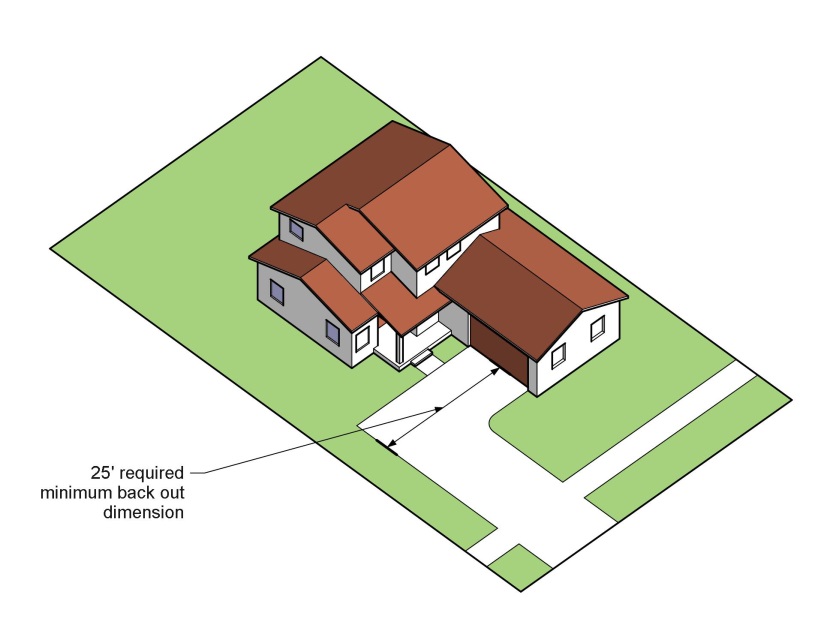
Figure 4.6-1: Side-load Garage
3. Side Yard Restrictions. No driveway or parking surface located in the side yard shall exceed a width of 10 feet.
4. Rear Yard Restrictions.
a. All driveways or parking surfaces located in the rear yard of lots smaller than 20,000 square feet without alley access shall not cover more than 25 percent of the total rear yard area or 750 square feet, whichever is less.
b. All driveways or parking surfaces located in the rear yard of lots smaller than 20,000 square feet with alley access for the purpose of serving alley-loaded garages and lots with either attached garages on the rear elevation of the residence or detached garages located in the rear lot setback shall not exceed 50 percent of the total rear yard area.
c. All driveways or parking surfaces located in the rear yard on lots greater than 20,000 square feet in area shall not exceed 750 square feet.
d. Guest parking may be provided in private driveways (tandem parking) leading to individual buildings; provided, that no parked vehicle encroaches on or over public or private streets or sidewalks.
5. Surfacing.
a. Driveways or parking surfaces abutting paved public rights-of-way are required to be surfaced with concrete, asphalt, or brick or stone pavers.
b. Driveways or parking surfaces abutting unpaved public rights-of-way in open, natural areas, and agricultural districts, are not required to be surfaced with concrete, asphalt, or brick or stone pavers.
c. Driveways or parking surfaces abutting unpaved streets in residential zones are not required to be surfaced with concrete, asphalt, or brick or stone pavers. However, driveways or parking surfaces shall be of standards in conformity with those adopted by the Director of Public Works. Standards shall address construction, placement, material, drainage, and containment.
6. Garage Required. In Subareas B and C, single-family detached and two-family dwellings shall include a garage structure large enough to fully enclose at least one off-street parking space per dwelling on the same lot as the residential structure.
7. Garage Design. In all Subareas, if a garage is provided, the garage structure may be attached or detached from the main dwelling, and shall meet the following standards:
a. It shall be of a similar design, quality, and style as the main residential structure, using the same façade and roofing materials or mixture of materials as found on those portions of the main residential structure facing the street.
b. It shall include at least four square feet of window area, including any window areas located within overhead or swinging doors. Such window areas shall admit light, but may be either transparent or translucent.
8. Garage Variation Required.
a. In single-family detached residential subdivisions that contain four lots or more in Subareas B and C, and that are not using the Subarea C Small Residential Lot Standards from Section 146-4.2.3.A, the following standards shall be met:
i. At least 50 percent of the total number of lots in the subdivision or block shall have recessed garage configurations, alternate-load garage configurations, or any combination of either.
ii. A recessed garage configuration is a home design having all its street-facing garage doors recessed at least five feet behind the home's front building line as shown in Figure 4.6-2. A front building line shall be a home's most forward nongarage wall plane at least10 feet wide. It may include the front line of a front porch, provided the porch has a roof and is at least five feet deep and eight feet in width.
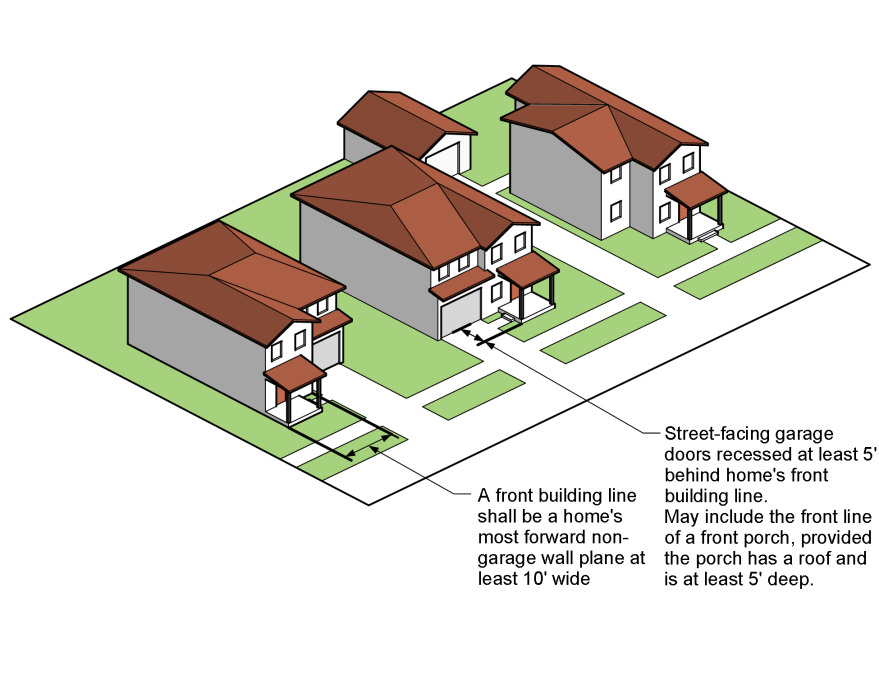
Figure 4.6-2: Recessed Garage
iii. For the purposes of this Section 146-4.6.5.C.8, an alternate-load garage configuration shall be defined as a home design having garage doors facing in a direction other than the street on which the home fronts, as shown in Figure 4.6-3. Where used as an alternate-load design, a side-load garage shall have at least one garage door oriented perpendicular to the front elevation of the house with the enclosed portion of the garage on the front elevation comprising a maximum of 60 percent of the total front elevation width.
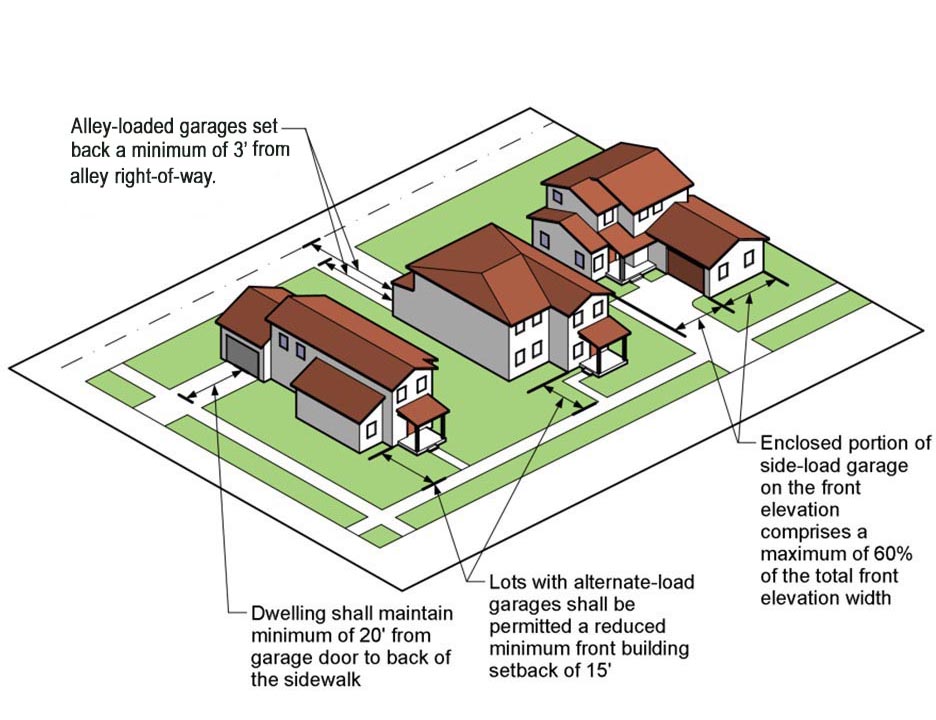
Figure 4.6-3: Alternate-load Garage
iv. House lots with alternate-load garages shall be permitted a reduced minimum front building setback of 15 feet for all portions of the building, including the garage, except that every dwelling shall maintain a minimum of 20 feet from the garage door to the back of the sidewalk, or to the back of the curb if no sidewalk is present. Alley-load garages shall be set back a minimum of three feet from the alley right-of-way. Lots with alternative-load garages shall be exempted from the driveway area restrictions of this UDO. All garage configurations shall avoid layouts where parking on the driveway will overhang sidewalks or public rights-of-way.
9. Garage Doors as a Percentage of Front Façades. In all Subareas, where a garage door or doors accommodating one or two cars in non-tandem configuration appear on the front of a residential structure, the door or doors shall not occupy more than 47 percent of the total width of the front elevation. For garages built to accommodate three or more vehicles in non-tandem configuration, the garage doors shall not occupy more than 55 percent of the total width of the front elevation. All three-car garages shall have a minimum two foot offset between the single and double garage doors, or between two single doors if three single doors are provided.
D. Parking Lot Layout and Design.
1. Landscaping and Screening. All surface parking lots shall comply with the landscaping and screening standards applicable to parking lots in Section 146-4.7.5.K (Parking Lot Landscaping).
2. Pedestrian Walkways. In parking lots containing more than 150 contiguous spaces, sidewalks or paths at least six feet in width and designated by painted lines, raised surfaces, or different surfacing colors or materials shall be provided within a landscaped median to provide safe pedestrian access from the farthest parking block, row, or bay to the primary entrance of each building the parking area serves.
3. Parking Blocks. Each parking lot containing more than 150 spaces shall divide the parking area into “parking blocks”, each containing no more than 120 vehicle parking spaces to the maximum extent practicable in light of the shape and orientation of the parking lot and the location of access points to the parking lot. Each parking block shall be separated from other parking blocks by a driving aisle with a center landscaped swale, median, or area at least 20 feet in width.
4. Tandem Parking.
a. In Subarea A, all required parking spaces shall be individually accessible except for guest parking in private driveways leading to dwellings, designated employee parking for non-residential uses, and residential parking spaces assigned to a specific unit in a multifamily dwelling.
b. In Subareas B and C, all required parking spaces shall be individually accessible except for guest parking in private driveways leading to single-family detached, single- family attached, and two-family dwellings. Unless otherwise stated, tandem parking for the purpose of meeting minimum parking requirements is prohibited.
5. Overhangs.
a. Parking areas for public use shall be designed so that a parked vehicle does not overhang the public right-of-way, fire lane easement, public sidewalk, or trail unless the right-of-way, fire lane easement, sidewalk, or trail is widened by the amount of the overhang and does not reduce the width of an area or route required to meet the standards of the Americans with Disabilities Act.
b. A parked vehicle may overhang a landscaped area by up to two feet; provided, that the width of the landscape area is increased by the amount of parked vehicle overhang.
c. A permanent curb, bumper, wheel stop, or similar devise shall be installed no closer than two feet from the end of each parking space adjacent to a public right-of-way, public sidewalk, or planters to protect those areas from vehicle overhangs and to protect structures from vehicle damage.
6. Stall Size and Drive Aisle Dimensions.
a. Parking areas and required spaces, drive aisles, and maneuvering areas shall comply with the dimensional standards in the table below.
|
Table 4.6-4 Off-Street Parking Layout Dimensions |
||||
|---|---|---|---|---|
|
0° (parallel) |
45° |
60° |
90° (head-in) |
|
|
Standard Spaces |
||||
|
Curb length per space |
23 ft. |
12.7 ft. |
10.4 ft. |
9 ft. |
|
Space depth |
23 ft. |
19.8 ft. |
21 ft. |
19 ft. |
|
Space width |
8 ft. |
9 ft. |
9 ft. |
9 ft. |
|
Access aisle width (1 way / 2 way) |
12/22 ft.[1] |
13/22 ft. [1] |
18/22 ft. [1] |
23 ft. |
|
Notes: [1] Additional width may be required where aisle serves as the principal means of access to on-site buildings or structures. |
||||
b. For parking designs other than those indicated in Table 4.6-4, the minimum dimensions shall be determined by the Planning Director.
7. Surfacing.
a. Generally. All parking areas shall be properly graded for drainage and shall be surfaced with concrete or asphalt, brick or stone pavers meeting Public Works Department standards. All portions of Parking Lots that exceed 125 percent of the minimum on-site parking required for a lot or a development shall use alternative materials pursuant to Subsection 7.b below.
b. Alternative Materials. Alternative materials including pervious or semi-pervious parking materials may be approved if the Director of Public Works determines that the materials are durable and can be maintained over time. These alternative paving materials include but are not limited to grass, mulch, grasscrete, ring and grid systems used with grass, permeable concrete or asphalt, porous pavers, or recycled materials such as glass, rubber, used asphalt, brick, block, and concrete.
8. Marking of Spaces.
a. Parking spaces shall be marked on the pavement. Any other directional markings or signs shall be installed as permitted or required by the City to ensure the approved use of space, direction of traffic flow, and general safety.
b. Required off-street parking spaces shall be delineated by four-inch-wide single- or double-striped lines in the configurations shown in Fig. 4.6-4.

Figure 4.6-4: Alternative Stall Markings and Wheel Stop Locations
E. Parking Garage Design.
1. Design. Above ground parking garages or portions of structures occupied by automobile parking shall meet the following standards:
a. The minimum setback for a parking garage shall be the same that is required for the principal structure.
b. The height of an accessory parking garage shall not exceed the height of the principal structure it is intended to serve. This standard does not apply to parking garages intended to serve transit stations that are one story or less in height.
c. Where the top parking level of a parking garage is not enclosed, lighting for the top parking level may not exceed 12 feet above the parking surface.
d. Each façade facing a public street shall conceal the view of all parked cars below the hoodline and the view of internal light sources, when viewed from the property street frontage.
e. All parking surfaces along any street frontage of the garage shall be generally horizontal, rather than an angled surface or ramp leading to a higher or lower level of the garage.
f. Elements such as decorative grillwork, louvers, or translucent materials consistent with building code requirements for open parking structure requirements shall be used on the upper floor façades, or the upper parking floors shall be designed with a pattern of window-like openings on the parking garage façade.
g. In Subarea A, and in the Core subdistrict of the MU-TOD district, ground floor parking garage frontages on collector or arterial streets shall be designed with a minimum floor-to-ceiling height of 11 feet to a depth of at least 20 feet from the street frontage, so that area can be converted to a pedestrian-active retail or service use in the future.
h. In all Subareas, the ground floor of a parking structure shall employ one or more of the options shown in Table 4.6-5, below to improve visual interest of the ground floor façade. Parking structures without ground-floor active uses shall comply with required landscaping per Section 146-4.7.5.J.2.d.
|
Table 4.6-5 Parking Structure Screening Methods |
|
|---|---|
|
Storefront with Active Use – Often referred to as a “wrap”, this includes locating an active use such as, but not limited to, retail, restaurant, office, residential, commercial, or civic space between the parking structure and public space. |
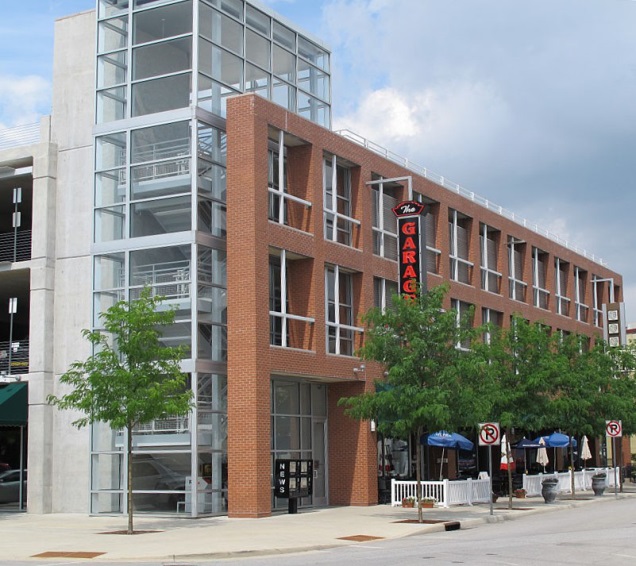
|
|
Public Art – Using public art, such as a mural or sculptural element integrated into the façade. |
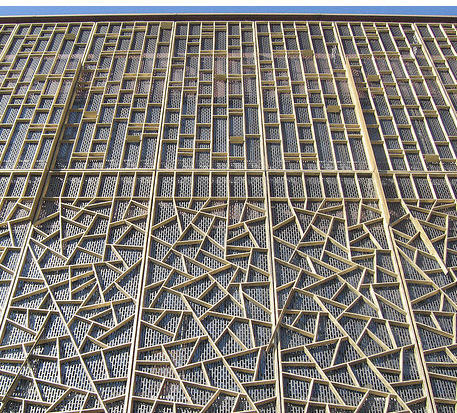
|
|
Display Cases – Display cases could be used to display retail goods, art, banners, and more. |
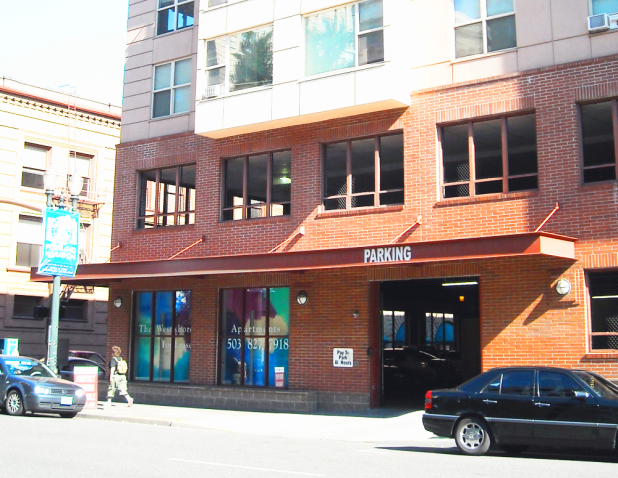
|
|
Landscape Wall – Incorporating green landscaping into the façade of a parking structure at the ground floor also provides interest. This can be done with vines, vertical gardens, or other living plant material. |

|
2. Pedestrian and Vehicular Circulation.
a. Where pedestrians cross primary vehicular routes to access stairways, elevators, or other entries, a marked and signed crosswalk shall be provided.
b. Parking ramp slopes shall not exceed the 6.67 percent slope, or the maximum parking slope permitted in the Adopted Building Code for the City of Aurora. (Ord. No. 2023-41 § 3, 09-11-2023; Ord. No. 2019-49 § 1, 08-19-2019)